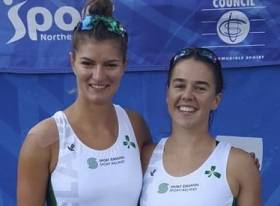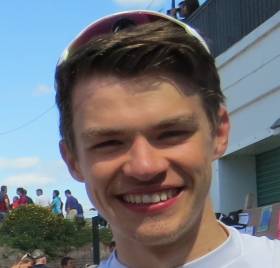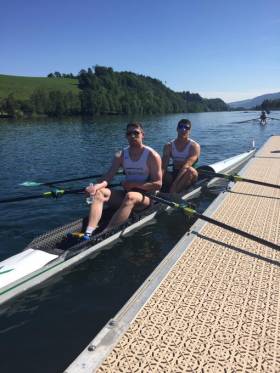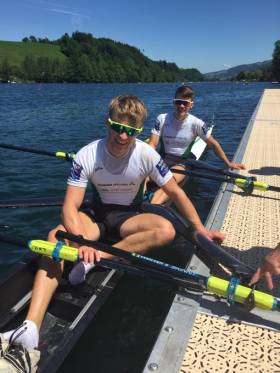Displaying items by tag: Lydia Heaphy
Gary O'Donovan Tenth Overall at World Rowing Championships
#Rowing: Ireland's Gary O'Donovan took fourth in his B Final of the lightweight single sculls at the World Rowing Championships in Linz-Ottensheim.
Rainer Kepplinger of Austria won, with O'Donovan part of group close behind. The finish puts O'Donovan 10th overall here.
Alice Arch of Australia won the women's lightweight single, with Ireland's Lydia Heaphy fifth. Heaphy had led through the first quarter.
The Ireland lightweight quadruple took second to the United States in their B Final.
World Rowing Championships, Linz-Ottensheim, Day Six (Irish interest)
Men
Lightweight Quadruple - B Final: 1 United States 6:03.94, 2 Ireland (H Sutton, M Taylor, R Ballantine, J McCarthy) 6:06.62.
Lightweight Single - B Final (places 7 to 12): 1 Austria (R Kepplinger) 7:00.16; 4
Ireland (G O'Donovan) 7:02.18.
Women
Lightweight Single - B Final (places 7 to 12): 1 Australia (Alice Arch) 7:52.59; 5 Ireland (L Heaphy) 7:55.40.
#Rowing: Ireland brought its tally of boats qualified for the next round to eight this morning at the World Rowing Championships in Linz, Austria.
The women's four of Tara Hanlon, Eimear Lambe, Aifric Keogh and Emily Hegarty slotted into the semi-finals by taking second behind China in their repechage.
Lydia Heaphy qualified for the semi-final with a third placing the repechage of the lightweight single sculls.
The men's lightweight quadruple fell just short of qualifying for the A Final. The crew of Hugh Sutton, Miles Taylor, Ryan Ballantine and Jake McCarthy finished fifth, with four going through. The Netherlands won from Denmark, Austria and Ireland, with the United States sixth.
World Rowing Championships, Linz, Austria, Day Three (Irish interest)
Men
Lightweight Qudaruple Sculls – Repechage (First Four to A Final; rest to B Final): 5 Ireland (H Sutton, M Taylor, R Ballantine, J McCarthy) 5:58.99.
Women
Four – Repechage One (First Three to A/B Semi-Final; rest to C Final): 2 Ireland (T Hanlon, E Lambe, A Keogh, E Hegarty) 6:35.14
Lightweight Single – Repechage Two (First Three to A/B Semi-Final; rest to C Final): 3 Ireland (L Heaphy) 7:48.40.
Gary O'Donovan Stops and Misses Out on First Chance of Qualification Place at World Championships
#Rowing: The two Ireland lightweight single scullers missed out on qualification from their heats at the World Rowing Championships – but in different fashions. Lydia Heaphy held the second and final qualification spot for the semi-final through much of her race only to be caught coming up to the line by Martine Veldhuis of the Netherlands. Heaphy missed out by just .3 of a second in a race won by Marie-Louise Draeger of Germany.
Gary O’Donovan was in fifth place in his heat of the lightweight single at 1,000 metres and seemed in striking distance of a top-three place which would have sent him to the quarter-finals. However, he stopped and then paddled home fourth. He will have to come through a repechage to secure a place in the quarter-finals.
World Rowing Championships, Linz, Austria, Day One (Irish interest)
Men
Pair – Heat One (First Four to Quarter-Finals; rest to Repechage): 6 Ireland (M O’Donovan, S O’Driscoll) 6:50.51.
Lightweight Double Sculls – Heat Three (First Three to Quarter-Finals; rest to Repechage): 1 Ireland (F McCarthy, P O’Donovan) 6:28.02
Lightweight Single Sculls – Heat Four (First Three to Quarter-Finals; rest to Repechage): 4 Ireland (G O’Donovan) 8:06.49.
Women
Four – Heat One (First Two to A/B Semi-Finals; rest to Repechage): 3 Ireland (T Hanlon, E Lambe, A Keogh, E Hegarty) 6:44.72.
Pair – Heat Four (First Four to Quarter-Finals; rest to Repechage): 2 Ireland (A Crowley, M Dukarska) 7:13.30
Lightweight Double Sculls – Heat Four (First Four to Quarter-Finals; rest to Repechage): 4 Ireland (A Casey, D Walsh) 7:25.62.
Lightweight Single Sculls – Heat Three (First Two to A/B Semi-Finals; rest to Repechage): 3 Ireland (L Heaphy) 8:01.79.
Ireland's Dukarska and Crowley Sixth at Rotterdam World Cup
#Rowing: Ireland's Aileen Crowley and Monika Dukarska took sixth in the A Final of the women's pairs at the World Cup Regatta in Rotterdam. Ireland featured well in the early stages, but Australia and New Zealand moved away. They would finish in that order after a good battle. Britain took the bronze. Ireland and Spain battled for fifth, with Spain taking it by 1.63 seconds.
Lydia Heaphy and Denise Walsh finished sixth in their B Final of the lightweight double sculls, to take 12th overall.
World Cup Regatta, Rotterdam, Day Three (Irish interest)
Women
Pair - A Final: 1 Australia 7:26.15, 2 New Zealand 7:27.57, 3 Britain 7:40.51; Ireland (A Crowley, M Dukarska) 7:50.08.
Lightweight Double Sculls - B Final (places 7 to 12): 6 Ireland (L Heaphy, D Walsh) 7:45.98.
#Rowing: Paul O'Donovan and Fintan McCarthy brought the tally of Ireland A Finalists at the World Cup Regatta in Rotterdam to four with a second-placed finish in their semi-final. Germany's Jason Osborne and Jonathan Rommelmann, racing in the favoured lane one were the dominant crew, but the new Ireland lightweight double finished fast, coming to just about a length on the line.
The Ireland women's lightweight double were out in lane six in the revised lane draw in their semi and finished sixth. Lydia Heaphy and Denise Walsh are set for a B Final.
World Cup Regatta, Rotterdam, Day Two (Irish interest; morning session)
Men
Double Sculls - Semi-Final Two (First Three to A Final; rest to B Final): 1 Ireland (P Doyle, R Byrne) 6:33.47, 2 Germany 6:36.17, 3 Australia One 6:38.62
Lightweight Double Sculls - Semi-Final Two (First Three to A Final; rest to B Final): 1 Germany One 6:42.04, 2 Ireland (F McCarthy, P O'Donovan) 6:43.70, 3 Australia 6:50.80.
Lightweight Single Sculls - Semi-Final Two (First Three to A Final; rest to B Final): 1 Slovenia 7:22.30, 2 3 Ireland One (G O'Donovan) 7:25.89, 3 Switzerland 7:27.70; 4 Ireland Two (J McCarthy) 7:34.79.
Women
Pair - Semi-Final One (First Three to A Final; rest to B Final): 1 Romania One 7:34.61, 2 Ireland (A Crowley, M Dukarska) 7:37.87, 3 Spain 7:39.49.
Lightweight Double Sculls - Semi-Final Two (First Three to A Final; rest to B Final): 6 Ireland (L Heaphy, D Walsh) 7:49.87.
Italy Catch Doyle and Byrne on Line at European Rowing
#Rowing: Ireland’s Philip Doyle and Ronan Byrne finished fourth in their B Final, tenth overall, at the European Rowing Championships in Lucerne this morning. In a good race with an exciting finish, Germany led off as if they intended to dominate. Ireland headed a pack of three who were closest to them. Lithuania were fastest through the last 700 metres and almost caught Germany on the line, while Ireland were pushed out of third by Italy by 17 hundredths of a second.
Lydia Heaphy and Denise Walsh took sixth in their B Final, 12th overall. The Netherlands were impressive winners.
European Championships, Lucerne, Day Three (Irish interest)
Men
Double Sculls – B Final (Places 7 to 12): 1 Germany 6:19.30, 2 Lithuania 6:19.44, 3 Italy 6:22.64, 4 Ireland (P Doyle, R Byrne) 6:22.81
Women
Lightweight Double Sculls – B Final (Places 7 to 12): 1 Netherlands 7:05.12; 6 Ireland (D Walsh, L Heaphy) 7:22.38.
#Rowing: The McCarthy twins, Jake and Fintan, took their place in the A Final of the lightweight double sculls at the European Rowing Championships in Lucerne today. They slotted into third place in their semi-final, almost level with Spain after both crews had chased the winners, Germany. The Czech Republic missed out in fourth.
The Ireland women’s lightweight double of Lydia Heaphy and Denise Walsh took sixth in their semi-final and go the the B Final.
European Championships, Lucerne, Day Two (Irish interest)
Men
Double Sculls – Semi-Final One (First Three to A Final; rest to B Final): 1 Netherlands 6:11.71, 2 Britain 6:12.61, 3 France 6:13.81; 4 Ireland (P Doyle, R Byrne) 6:14.37.
Lightweight Double Sculls - Semi-Final One (First Three to A Final; rest to B Final): 1 Germany 6:16.29, 2 Spain 6:17.83, 3 Ireland (F McCarthy, J McCarthy) 6:17.97; 4 Czech Republic 6:18.78.
Lightweight Single Sculls – C Final (Places 13 to 17): 1 Austria (R Kepplinger) 7:09.42; 4 Ireland (G O’Donovan) 7:18.11.
Women
Lightweight Double Sculls – Semi-Final Two (First Three to A Final; rest to B Final): 1 Switzerland 6:55.47, 2 Italy 6:55.92, 3 Romania 6:56.25; 6 Ireland (D Walsh, L Heaphy) 7:18.75.
McCarthys Shine at European Rowing
#Rowing: Jake and Fintan McCarthy produced a brilliant final sprint to take a place in the semi-finals of the lightweight double sculls at the European Rowing Championships in Lucerne today. Just two crews would go through, and Italy led the way. The world silver medallists stayed ahead of a tight pack of challengers, with Ukraine closest as they came to the line. But the McCarthy twins upped their rate and pushed Ukraine out of a qualifying spot by a quarter of a second.
Lydia Heaphy and Denise Walsh, a new crew, did very well to qualify directly for their semi-final. They took the third and final qualifying spot in their heat. Switzerland and Britain fought it out at the head of the field, with Ireland holding off Spain and Sweden.
European Championships, Lucerne, Day One (Irish interest)
Men
Double Sculls – Heat One (First Two to A/B Semi-Finals; rest to Repechages): 1 Ireland (P Doyle, R Byrne) 6:26.53, 2 Romania 6:29.62.
Lightweight Double Sculls – Heat Two (First Two to A/B Semi-Finals; rest to Repechages): 1 Italy (S Oppo, P Ruta) 6:14.73, 2 Ireland (J McCarthy, F McCarthy) 6:16.07; 3 Ukraine 6:16.32.
Lightweight Single Sculls – Heat One (First Two to A/B Semi-Finals; rest to Repechages): 1 Italy (M Goretti) 7:05.54, 2 Switzerland (J Schaeuble) 7:06.73; 6 Ireland (G O’Donovan) 7:34.73.
Women
Single Sculls – Heat Three (First Two to A/B Semi-Finals; rest to Repechages): 1 Ireland (S Puspure) 7:30.65, Britain (V Thornley) 7:35.35
Lightweight Double Sculls – Heat Three (First Three to A/B Semi-Finals; rest to Repechages): 1 Switzerland 6:57.58, 2 Britain 6:58.61, Ireland (D Walsh, L Heaphy) 7:14.55.
#Rowing: Jake and Fintan McCarthy raced brilliantly to win their heat and qualify directly for the A/B Semi-Finals at the World Under-23 Rowing Championships in Poland this morning. There was just one direct qualification place on offer in this heat of the lightweight double sculls and Italy gave Ireland quite a race. The two crews were locked together as they approached the 1500-metre mark – but then the McCarthy twins went. They led by .18 of a second at 1500 metres and sprinted away from their rivals to win well.
Lydia Heaphy and Margaret Cremen made a solid start to their campaign in the women’s lightweight double by taking the second and final qualification spot in their heat. They were fastest to the 500 metre mark, but Britain’s Susannah Duncan and Danielle Semple took over from there. They would build their lead to win by almost eight seconds. Cremen and Heaphy secured their spot, staying well clear of third-placed Poland.
World Under-23 Championships, Poznan, Poland (Irish interest; selected results)
Men
Lightweight Double Sculls – Heat Three (First to A/B Semi-Finals; rest to Repechage): 1 Ireland (F McCarthy, J McCarthy) 6:35.94.
Women
Lightweight Double Sculls – Heat Four (First Two to A/B Semi-Finals; rest to Repechage): 2 Ireland (L Heaphy, M Cremen) 7:37.99.

































































